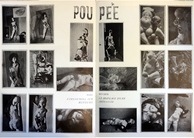The Loneliness of Digital Devices: Examining "Removed" (Photo Series) by Eric Pickersgill
By
2016, Vol. 8 No. 03 | pg. 2/2 | « FamiliesThroughout his photo series, Pickersgill photographs individuals of many different age groups; however, he repeats families and children numerous times, including them in five of his images. In her book, Turkle explains that though many children with stable familial environments and homes do not experience physical forms of abuse, they experience other forms of abandonment by their parents. Instead, these children’s parents are “preoccupied, often by what is on their cellphones” (Turkle, 163). Therefore, even though children desire the “pleasure of [parents’] full attention,” which is “coveted and rare” (Turkle, 240), they are forced to surrender to the invisible ghost of technology that receives their parents’ continuous and undivided attention on a daily basis. In the fourth photograph, a child is depicted doing outdoor chores while his parents grill and look down at their cellphones. The scene appears to be set in a nice neighborhood with a large, brick house in the background and two cars in the driveway, showing the family’s respectable socioeconomic status. Though the photograph may initially look like a portrait of a happy family spending time with one another, after a closer look, the audience can see that this image captures just the opposite. The mother and father appear to be spending quality time together while making a meal for dinner, but it is soon evident that the two are multitasking in “cruise control” (Turkle, 240) with the father grilling and the mother sitting in the bed of the pickup truck while both stare at something in their electronic devices. The mother and father have an uncomfortably large amount of space between them as though disconnected, while their son stands close to his father, leaning slightly towards him as though longing for a sense of love or connection. The way that his father’s back is turned away from the little boy makes it seem as though he is rejecting his own flesh and blood. Furthermore, neither parent seems aware or concerned with the fact that an unusual amount of steam appears to be coming from the grill, that a photographer is documenting this moment in time, or that their child feels lonely and rejected.The child, the only one acknowledging the photographer, stares into the lens with one of his arms limp at his side, as though giving up on trying to receive the attention from his parents that he desires. His downturned lips and wide eyes make it seem as though he were asking for help, begging the viewers and the photographer for the love and attention he does not receive from his parents. The basketball hoop in the background, which symbolizes childhood, further emphasizes the boy's young age and innocence because of its contrast to the rake in his hand used for yard work. As Turkle’s writes, “today, children contend with parents who are physically close, tantalizing so, but mentally elsewhere” (Turkle, 240). As a result, children experience negative feelings of not being wanted and ultimately, being disliked. Turkle’s concept of shared attention between children and cellphones can have devastating effects. Not only do children “associate technology with shared attention” (Turkle, 240), but also, according to Alexander, children are losing their ability to fully interact in social environments. Specifically, because “very young children learn about their world largely through face-to-face interactions, vocalizations, and touching with parents” (Alexander), Turkle believes that digital technology keeps children from learning to read people’s faces and specifically, learning their “‘nuances of feeling’” (Turkle, 244). As a result, children are not only isolated from their parents, but also one another because they are unsure of the proper communication techniques and methodologies to making friends. In the fifth photograph, two young boys are at the dinner table playing on their own while their mother and father sit and stand next to them staring down at their hands where their electronic devices would be. Similar to the previous picture, the couple has an awkward space in between each other while the children are close to one of the parents, the mother in this case, as though longing for her attention. However, in this image, rather than staring into the camera’s lens, the children appear to be mesmerized by their own distractions: their toys. Through this image, Pickersgill aims to create a comparison between a traditional family dinner and the new norms of “postfamilial families” (Turkle, 251). In these family types, members are no longer concerned with traditional family rituals. Instead, they move toward new ideologies of being physically present while performing activities that satisfy their own personal needs and desires. With the rise of postfamilial families, according to Alexander, a study performed in 2014 found that eighty percent of parents use their phone throughout meals to surf the Internet, work, and check their email. Though each individual may be happy and satisfying their needs in the short run, there are various consequences and insecurities that come with the move from communication and interaction around the dinner table. Specifically, in this image, rather than laughing and playing with one another, each boy sits at opposite ends of the table with his own game, quietly playing with neutral and unexcited facial expressions. Like “newborns… gaze into a mother’s eyes seeking social information” (Alexander), children look toward their parents to help them understand basic ways of communicating with others, especially with other kids their age. Pickersgill’s image showing a lack of contact between all parties in the family, especially the two boys, shows the children’s inability to socially connect and mingle because of the parents’ neglect caused by cellphone addiction. While many children are like those pictured in this image, a number of children pester their parents persistently unless constantly entertained. Goldberg describes the situation of parents using electronics like babysitters as technology use increases in every day life, creating the norm of “passing back” phones to fussy children. Health Day News observed that in 2015, 73% percent of children play with their parents’ phones or tablets while they did work around the house and sixty percent use them while their parents ran errands. Because The American Academy of Pediatrics discourages screen time for children under the age of two, this evolving norm created a lot of controversy, especially because the need for constant attention and entertainment could lead to learning disabilities such as short attention spans or Attention Deficit Disorder (ADD) later in children’s lives. Moreover, the use of technology in particular can lead to cellphone addiction. This 'digital babysitter' is depicted in the last photograph, in which three young boys sit on the couch together as each stares down at his own electronic device. Unlike a common photograph of children playing together, rather than running around and laughing, this image shows the boys sitting quietly with very serious and unconcerned facial expressions, similar to the way the photographer depicts the boys in the previous image. Pickersgill uses this image as a comparison between the effects of technology usage in young children and previous images of parents using technology while their children longed for their attention. These children, “alone together” with their electronic devices, possess the same hypnotized looks, squinting eyes, bowed heads, and furrowed eyebrows that the parents reveal in previous images. Pickersgill is pointing out the inevitable circular movement of parenting with technology. When children lack attention from their parents but are given electronics to entertain themselves with, they look toward cellphones rather than friends and peers to “offer communities when families are absent” (Turkle, 163). As a result, with the growth of technology, children are spending time together, yet they are no longer communicating and interacting with one another. With the growing culture of “passing back” parenting, children are becoming miniature robots, transforming into the unaware, indifferent individuals their parents are to them. Conclusion: The Loneliness of our DevicesAs Turkle points out, with the growing reliance on technology, “research portrays Americans as increasingly insecure, isolated, and lonely” (145). Traditional norms are constantly changing and evolving as individuals separate themselves from family members and lovers because they fear intimacy. In his images, Pickersgill seeks to address these issues, primarily by photographing traditional situations but with the incorporation of technology and its effects on different groups of people. By pointing out the reality of technology use, Pickersgill urges people to make a change in order to become more involved in each other’s lives. He pushes all Americans and individuals around the world to step outside their comfort zone, choosing to overcome the fear of being intimate and involved with other people. Though the smartphone may be a beneficial resource, it should not engulf a person’s entire life. Cellphones are meant to connect people, not isolate them. Instead, the best source of entertainment and inclusion comes from the people who surround us. ReferencesAlexander, Brian. “Put Down That Cellphone! Study Finds Parents Distracted by Devices.” NBC News. NBC News, 10 Mar. 2014. Web. 10 Nov. 2015. Archer, Dale. “Smartphone Addiction.” Psychology Today. Sussex Publishers, LLC, 25 July 2013. Web. 11 Nov. 2015. Goldenberg, Stephanie. “Parents Using Smartphones to Entertain Bored Kids.” CNN. Cable News Network, 27 Apr. 2010. Web. 11 Nov. 2015. Haelle, Tara. “Very Young Kids Often Use Tablets, Smartphones, Study Finds.” Consumer HealthDay. HealthDay, 26 Apr. 2015. Web. 10 Nov. 2015. Lin, Helen Lee. “How Your cellphone Hurts Your Relationship.” Scientific American Global RSS. Scientific American, a Division of Nature America, Inc., 4 Sept. 2012. Web. 15 Nov. 2015. “Mobile Technology Fact Sheet.” Pew Research Center Internet Science Tech RSS. Pew Research Center, Updated October 2014. Retrieved from: http://www.pewinternet.org/fact-sheets/mobile-technology-fact-sheet/ Pickersgill, Eric. Removed. 2015. Photographs. http://www.removed.social/about/ Turkle, Sherry. Alone Together: Why We Expect More from Technology and Less from Each Other. New York: Basic Books, 2012. Print. Winch, Guy. “How Cellphone Use Can Disconnect Your Relationship.” Psychology Today. Sussex Publishers, LLC., 13 Jan. 2015. Web. 17 Nov. 2015. Suggested Reading from Inquiries Journal
Inquiries Journal provides undergraduate and graduate students around the world a platform for the wide dissemination of academic work over a range of core disciplines. Representing the work of students from hundreds of institutions around the globe, Inquiries Journal's large database of academic articles is completely free. Learn more | Blog | Submit Latest in Visual Arts |


















